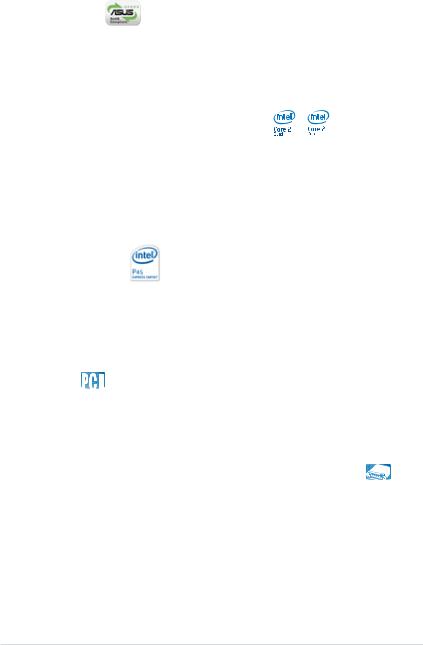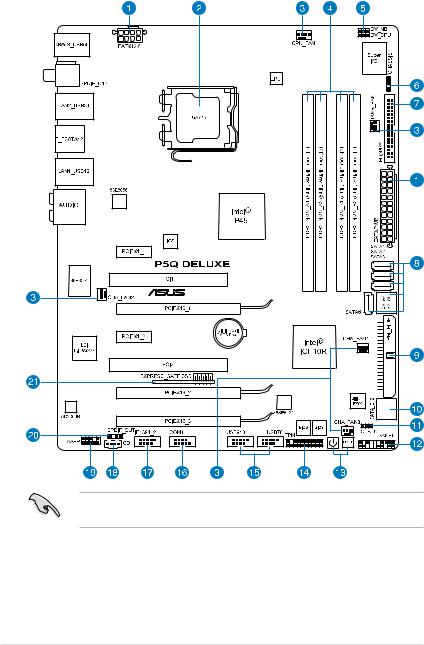Asus P5Q User Manual

P5Q Deluxe
Motherboard

E3913
Second Edition (V2)
May 2008
Copyright © 2008 ASUSTeK COMPUTER INC. All Rights Reserved.
No part of this manual, including the products and software described in it, may be reproduced, transmitted, transcribed, stored in a retrieval system, or translated into any language in any form or by any means, except documentation kept by the purchaser for backup purposes, without the express written permission of ASUSTeK COMPUTER INC. (“ASUS”).
Product warranty or service will not be extended if: (1) the product is repaired, modified or altered, unless such repair, modification of alteration is authorized in writing by ASUS; or (2) the serial number of the product is defaced or missing.
ASUS PROVIDES THIS MANUAL “AS IS” WITHOUT WARRANTY OF ANY KIND, EITHER EXPRESS OR IMPLIED, INCLUDING BUT NOT LIMITED TO THE IMPLIED WARRANTIES OR CONDITIONS OF MERCHANTABILITY OR FITNESS FOR A PARTICULAR PURPOSE. IN NO EVENT SHALL ASUS, ITS DIRECTORS, OFFICERS, EMPLOYEES OR AGENTS BE LIABLE FOR ANY INDIRECT, SPECIAL, INCIDENTAL, OR CONSEQUENTIAL DAMAGES (INCLUDING DAMAGES FOR LOSS OF PROFITS, LOSS OF BUSINESS, LOSS OF USE OR DATA, INTERRUPTION OF BUSINESS AND THE LIKE), EVEN IF ASUS HAS BEEN ADVISED OF THE POSSIBILITY OF SUCH DAMAGES ARISING FROM ANY DEFECT OR ERROR IN THIS MANUAL OR PRODUCT.
SPECIFICATIONS AND INFORMATION CONTAINED IN THIS MANUAL ARE FURNISHED FOR INFORMATIONAL USE ONLY, AND ARE SUBJECT TO CHANGE AT ANY TIME WITHOUT NOTICE, AND SHOULD NOT BE CONSTRUED AS A COMMITMENT BY ASUS. ASUS ASSUMES NO RESPONSIBILITY OR LIABILITY FOR ANY ERRORS OR INACCURACIES THAT MAY APPEAR IN THIS MANUAL, INCLUDING THE PRODUCTS AND SOFTWARE DESCRIBED IN IT.
Products and corporate names appearing in this manual may or may not be registered trademarks or copyrights of their respective companies, and are used only for identification or explanation and to the owners’ benefit, without intent to infringe.
ii

Contents
Contents....................................................................................................... |
iii |
Notices....................................................................................................... |
viii |
Safety information....................................................................................... |
ix |
About this guide........................................................................................... |
x |
P5Q Deluxe specifications summary....................................................... |
xii |
Chapter 1: |
Product introduction |
|
|
1.1 |
Welcome!....................................................................................... |
1-1 |
|
1.2 |
Package contents......................................................................... |
1-1 |
|
1.3 |
Special features............................................................................ |
1-2 |
|
|
1.3.1 |
Product highlights............................................................ |
1-2 |
|
1.3.2 |
ASUS unique features..................................................... |
1-3 |
|
1.3.3 |
ASUS intelligent performance and |
|
|
|
overclocking features....................................................... |
1-7 |
Chapter 2: |
Hardware information |
|
|
2.1 |
Before you proceed...................................................................... |
2-1 |
|
2.2 |
Motherboard overview................................................................. |
2-2 |
|
|
2.2.1 |
Motherboard layout.......................................................... |
2-2 |
|
2.2.2 |
Layout contents............................................................... |
2-3 |
|
2.2.3 |
Placement direction......................................................... |
2-4 |
|
2.2.4 |
Screw holes..................................................................... |
2-4 |
2.3 |
Central Processing Unit (CPU).................................................... |
2-5 |
|
|
2.3.1 |
Installing the CPU............................................................ |
2-6 |
|
2.3.2 |
Installing the CPU heatsink and fan................................ |
2-9 |
|
2.3.3 |
Uninstalling the CPU heatsink and fan.......................... |
2-10 |
2.4 |
System memory.......................................................................... |
2-11 |
|
|
2.4.1 |
Overview......................................................................... |
2-11 |
|
2.4.2 |
Memory configurations.................................................. |
2-12 |
|
2.4.3 |
Installing a DIMM........................................................... |
2-17 |
|
2.4.4 |
Removing a DIMM......................................................... |
2-17 |
2.5 |
Expansion slots.......................................................................... |
2-18 |
|
|
2.5.1 |
Installing an expansion card.......................................... |
2-18 |
|
2.5.2 |
Configuring an expansion card...................................... |
2-18 |
|
2.5.3 |
Interrupt assignments.................................................... |
2-19 |
|
2.5.4 |
PCI slots........................................................................ |
2-20 |
iii

Contents
|
2.5.5 |
PCI Express x1 slots ..................................................... |
2-20 |
|
2.5.6 |
PCI Express 2.0 x16 slots ............................................. |
2-20 |
|
2.5.7 |
Universal PCI Express x16 slot . .................................... |
2-20 |
2.6 |
Jumpers |
....................................................................................... |
2-22 |
2.7 |
Onboard .......................................................................switches |
2-24 |
|
2.8 |
Connectors.................................................................................. |
2-25 |
|
|
2.8.1 .................................................. |
Rear panel connectors |
2-25 |
|
2.8.2 ........................................................ |
Internal connectors |
2-27 |
|
2.8.3 ............................................... |
Installing the optional fan |
2-40 |
2.9 |
Starting up ......................................................for the first time |
2-41 |
|
2.10 |
Turning off ...........................................................the computer |
2-42 |
|
|
2.10.1 .................................. |
Using the OS shut down function |
2-42 |
|
2.10.2 ............................ |
Using the dual function power switch |
2-42 |
Chapter 3: |
BIOS setup |
|
|
3.1 |
Managing and updating your BIOS............................................. |
3-1 |
|
|
3.1.1 |
ASUS Update utility......................................................... |
3-1 |
|
3.1.2 |
ASUS EZ Flash 2 utility................................................... |
3-4 |
|
3.1.3 |
AFUDOS utility................................................................ |
3-5 |
3.2 |
BIOS setup program..................................................................... |
3-7 |
|
|
3.2.1 |
BIOS menu screen.......................................................... |
3-8 |
|
3.2.2 |
Menu bar......................................................................... |
3-8 |
|
3.2.3 |
Navigation keys............................................................... |
3-8 |
|
3.2.4 |
Menu items...................................................................... |
3-9 |
|
3.2.5 |
Sub-menu items.............................................................. |
3-9 |
|
3.2.6 |
Configuration fields.......................................................... |
3-9 |
|
3.2.7 |
Pop-up window................................................................ |
3-9 |
|
3.2.8 |
Scroll bar......................................................................... |
3-9 |
|
3.2.9 |
General help.................................................................... |
3-9 |
3.3 |
Main menu................................................................................... |
3-10 |
|
|
3.3.1 |
System Time.................................................................. |
3-10 |
|
3.3.2 |
System Date.................................................................. |
3-10 |
|
3.3.3 |
Legacy Diskette A ......................................................... |
3-10 |
|
3.3.4 |
Language....................................................................... |
3-10 |
|
3.3.5 |
SATA 1-6......................................................................... |
3-11 |
|
3.3.6 |
Storage Configuration.................................................... |
3-12 |
iv

Contents
|
3.3.7 |
AHCI Configuration........................................................ |
3-13 |
|
3.3.8 |
System Information........................................................ |
3-14 |
3.4 |
Ai Tweaker menu........................................................................ |
3-15 |
|
|
3.4.1 |
Ai Overclock Tuner ....................................................... |
3-15 |
|
3.4.2 |
CPU Ratio Setting ........................................................ |
3-16 |
|
3.4.3 |
FSB Strap to North Bridge ............................................ |
3-16 |
|
3.4.4 |
DRAM Frequency ......................................................... |
3-16 |
|
3.4.5 |
DRAM CLK Skew on Channel A1/A2/B1/B2 ................ |
3-17 |
|
3.4.6 |
DRAM Timing Control ................................................... |
3-17 |
|
3.4.7 |
DRAM Static Read Control ........................................... |
3-18 |
|
3.4.8 |
DRAM Read Training .................................................... |
3-19 |
|
3.4.9 |
MEM. OC Charger......................................................... |
3-19 |
|
3.4.10 |
Ai Clock Twister ............................................................ |
3-19 |
|
3.4.11 |
Ai Transaction Booster ................................................. |
3-19 |
|
3.4.12 |
CPU Voltage ................................................................ |
3-20 |
|
3.4.13 |
CPU GTL Voltage Reference(0/2) ................................ |
3-20 |
|
3.4.14 |
CPU GTL Voltage Reference(1/3) ................................ |
3-20 |
|
3.4.15 |
CPU PLL Voltage .......................................................... |
3-20 |
|
3.4.16 |
FSB Termination Voltage .............................................. |
3-20 |
|
3.4.17 |
DRAM Voltage .............................................................. |
3-20 |
|
3.4.18 |
NB Voltage .................................................................... |
3-20 |
|
3.4.19 |
NB GTL Voltage Reference .......................................... |
3-21 |
|
3.4.20 |
SB Voltage .................................................................... |
3-21 |
|
3.4.21 |
PCIE SATA Voltage ....................................................... |
3-21 |
|
3.4.22 |
Load-Line Calibration ................................................... |
3-21 |
|
3.4.23 |
CPU Spread Spectrum ................................................. |
3-21 |
|
3.4.24 |
PCIE Spread Spectrum ................................................ |
3-22 |
3.5 |
Advanced menu.......................................................................... |
3-23 |
|
|
3.5.1 |
TPM Configuration......................................................... |
3-23 |
|
3.5.2 |
CPU Configuration......................................................... |
3-24 |
|
3.5.3 |
Chipset.......................................................................... |
3-26 |
|
3.5.4 |
Onboard Device Configuration...................................... |
3-27 |
|
3.5.5 |
USB Configuration......................................................... |
3-28 |
|
3.5.6 |
PCIPnP.......................................................................... |
3-29 |
3.6 |
Power menu................................................................................ |
3-30 |
|

Contents
|
3.6.1 |
Suspend Mode ............................................................. |
3-30 |
|
3.6.2 |
Repost Video on S3 Resume........................................ |
3-30 |
|
3.6.3 |
ACPI 2.0 Support........................................................... |
3-30 |
|
3.6.4 |
ACPI APIC Support....................................................... |
3-30 |
|
3.6.5 |
APM Configuration........................................................ |
3-31 |
|
3.6.6 |
Hardware Monitor.......................................................... |
3-32 |
3.7 |
Boot menu................................................................................... |
3-34 |
|
|
3.7.1 |
Boot Device Priority....................................................... |
3-34 |
|
3.7.2 |
Boot Settings Configuration........................................... |
3-35 |
|
3.7.3 |
Security.......................................................................... |
3-36 |
3.8 |
Tools menu.................................................................................. |
3-38 |
|
|
3.8.1 |
ASUS EZ Flash 2.......................................................... |
3-38 |
|
3.8.2 |
Drive Xpert Control ....................................................... |
3-39 |
|
3.8.3 |
Drive Xpert Mode Update.............................................. |
3-39 |
|
3.8.4 |
Express Gate................................................................. |
3-40 |
|
3.8.5 |
ASUS O.C. Profile......................................................... |
3-41 |
|
3.8.6 |
AI Net 2.......................................................................... |
3-42 |
3.9 |
Exit menu..................................................................................... |
3-43 |
|
Chapter 4: |
Software support |
|
|
4.1 |
Installing an operating system.................................................... |
4-1 |
|
4.2 |
Support DVD information............................................................. |
4-1 |
|
|
4.2.1 |
Running the support DVD................................................ |
4-1 |
|
4.2.2 |
Drivers menu................................................................... |
4-2 |
|
4.2.3 |
Utilities menu................................................................... |
4-3 |
|
4.2.4 |
Make disk menu.............................................................. |
4-5 |
|
4.2.5 |
Manual menu................................................................... |
4-6 |
|
4.2.6 |
ASUS Contact information............................................... |
4-6 |
|
4.2.7 |
Other information............................................................. |
4-7 |
4.3 |
Software information.................................................................... |
4-9 |
|
|
4.3.1 |
ASUS MyLogo3™........................................................... |
4-9 |
|
4.3.2 |
AI NET2.......................................................................... |
4-11 |
|
4.3.3 |
ASUS PC Probe II......................................................... |
4-12 |
|
4.3.4 |
ASUS AI Suite............................................................... |
4-18 |
|
4.3.5 |
ASUS AI Nap................................................................. |
4-20 |
|
4.3.6 |
ASUS Fan Xpert............................................................ |
4-21 |
vi

Contents
|
4.3.7 |
ASUS AI Booster........................................................... |
4-23 |
|
4.3.8 |
ASUS EPU–6 Engine.................................................... |
4-24 |
|
4.3.9 |
ASUS AI Direct Link....................................................... |
4-28 |
|
4.3.10 |
AI Audio 2 (SoundMAX® High Definition Audio utility)... |
4-30 |
|
4.3.11 |
ASUS Drive Xpert.......................................................... |
4-39 |
|
4.3.12 |
ASUS Express Gate SSD.............................................. |
4-50 |
4.4 |
RAID configurations................................................................... |
4-60 |
|
|
4.4.1 |
RAID definitions............................................................. |
4-60 |
|
4.4.2 |
Installing Serial ATA hard disks...................................... |
4-61 |
|
4.4.3 |
Intel® RAID configurations............................................. |
4-61 |
4.5 |
Creating a RAID driver disk....................................................... |
4-69 |
|
|
4.5.1 |
Creating a RAID driver disk without entering the OS.... |
4-69 |
|
4.5.2 |
Creating a RAID driver disk in Windows®...................... |
4-69 |
Appendix: |
CPU features |
|
|
A.1 |
Intel® EM64T.................................................................................. |
A-1 |
|
|
Using the Intel® EM64T feature...................................................... |
A-1 |
|
A.2 |
Enhanced Intel SpeedStep® Technology (EIST)......................... |
A-1 |
|
|
A.2.1 |
System requirements....................................................... |
A-1 |
|
A.2.2 |
Using the EIST................................................................. |
A-2 |
A.3 |
Intel® Hyper-Threading Technology............................................ |
A-3 |
|
|
Using the Hyper-Threading Technology ........................................ |
A-3 |
|
vii

Notices
Federal Communications Commission Statement
This device complies with Part 15 of the FCC Rules. Operation is subject to the following two conditions:
•This device may not cause harmful interference, and
•This device must accept any interference received including interference that may cause undesired operation.
This equipment has been tested and found to comply with the limits for a Class B digital device, pursuant to Part 15 of the FCC Rules. These limits are designed to provide reasonable protection against harmful interference in a residential installation. This equipment generates, uses and can radiate radio
frequency energy and, if not installed and used in accordance with manufacturer’s instructions, may cause harmful interference to radio communications. However, there is no guarantee that interference will not occur in a particular installation. If this equipment does cause harmful interference to radio or television reception, which can be determined by turning the equipment off and on, the user is encouraged to try to correct the interference by one or more of the following measures:
•Reorient or relocate the receiving antenna.
•Increase the separation between the equipment and receiver.
•Connect the equipment to an outlet on a circuit different from that to which the receiver is connected.
•Consult the dealer or an experienced radio/TV technician for help.
The use of shielded cables for connection of the monitor to the graphics card is required to assure compliance with FCC regulations. Changes or modifications to this unit not expressly approved by the party responsible for compliance could void the user’s authority to operate this equipment.
Canadian Department of Communications Statement
This digital apparatus does not exceed the Class B limits for radio noise emissions from digital apparatus set out in the Radio Interference Regulations of the Canadian Department of Communications.
This class B digital apparatus complies with Canadian ICES-003.
viii

Safety information
Electrical safety
•To prevent electrical shock hazard, disconnect the power cable from the electrical outlet before relocating the system.
•When adding or removing devices to or from the system, ensure that the power cables for the devices are unplugged before the signal cables are connected. If possible, disconnect all power cables from the existing system before you add a device.
•Before connecting or removing signal cables from the motherboard, ensure that all power cables are unplugged.
•Seek professional assistance before using an adpater or extension cord. These devices could interrupt the grounding circuit.
•Make sure that your power supply is set to the correct voltage in your area. If you are not sure about the voltage of the electrical outlet you are using, contact your local power company.
•If the power supply is broken, do not try to fix it by yourself. Contact a qualified service technician or your retailer.
Operation safety
•Before installing the motherboard and adding devices on it, carefully read all the manuals that came with the package.
•Before using the product, make sure all cables are correctly connected and the power cables are not damaged. If you detect any damage, contact your dealer immediately.
•To avoid short circuits, keep paper clips, screws, and staples away from connectors, slots, sockets and circuitry.
•Avoid dust, humidity, and temperature extremes. Do not place the product in any area where it may become wet.
•Place the product on a stable surface.
•If you encounter technical problems with the product, contact a qualified service technician or your retailer.
This symbol of the crossed out wheeled bin indicates that the product (electrical, electronic equipment and mercury-containing button cell battery) should not
be placed in municipal waste. Check local regulations for disposal of electronic products.
ix

About this guide
This user guide contains the information you need when installing and configuring the motherboard.
How this guide is organized
This guide contains the following parts:
•Chapter 1: Product introduction
This chapter describes the features of the motherboard and the new technology it supports.
•Chapter 2: Hardware information
This chapter lists the hardware setup procedures that you have to perform when installing system components. It includes description of the switches, jumpers, and connectors on the motherboard.
•Chapter 3: BIOS setup
This chapter tells how to change system settings through the BIOS Setup menus. Detailed descriptions of the BIOS parameters are also provided.
•Chapter 4: Software support
This chapter describes the contents of the support DVD that comes with the motherboard package and the software.
•Appendix: CPU features
The Appendix describes the CPU features and technologies that the motherboard supports.
Where to find more information
Refer to the following sources for additional information and for product and software updates.
1.ASUS websites
The ASUS website provides updated information on ASUS hardware and software products. Refer to the ASUS contact information.
2.Optional documentation
Your product package may include optional documentation, such as warranty flyers, that may have been added by your dealer. These documents are not part of the standard package.

Conventions used in this guide
To make sure that you perform certain tasks properly, take note of the following symbols used throughout this manual.
DANGER/WARNING: Information to prevent injury to yourself when trying to complete a task.
CAUTION: Information to prevent damage to the components when trying to complete a task.
IMPORTANT: Instructions that you MUST follow to complete a task.
NOTE: Tips and additional information to help you complete a task.
Typography
Bold text |
Indicates a menu or an item to select. |
Italics |
Used to emphasize a word or a phrase. |
<Key> |
Keys enclosed in the less-than and greater-than sign |
|
means that you must press the enclosed key. |
|
Example: <Enter> means that you must press the |
|
Enter or Return key. |
<Key1+Key2+Key3> |
If you must press two or more keys simultaneously, the |
|
key names are linked with a plus sign (+). |
|
Example: <Ctrl+Alt+D> |
Command |
Means that you must type the command exactly |
|
as shown, then supply the required item or value |
|
enclosed in brackets. |
|
Example: At the DOS prompt, type the command line: |
|
afudos /iP5QD.ROM |
xi

P5Q Deluxe specifications summary
CPU |
LGA775 socket for Intel® Core™2 Extreme / |
|
Core™2 Quad / Core™2 Duo / Pentium® dual-core / |
|
Celeron® dual-core / Celeron® Processors |
|
Compatible with Intel® 05B/05A/06 processors |
|
Intel® 45nm Multi-Core CPU support |
|
* Refer to www.asus.com for Intel CPU support list |
Chipset |
Intel® P45 / ICH10R with Intel® Fast Memory Access |
|
Technology |
System Bus |
1600 / 1333 / 1066 / 800 MHz |
Memory |
4 x DIMM, max. 16GB, DDR2 1200 / 1066 / 800 / |
|
667 MHz, non-ECC, un-buffered memory |
|
Dual channel memory architecture |
|
* Refer to www.asus.com or this user manual for the |
|
Memory QVL (Qualified Vendors Lists). |
|
** When installing total memory of 4GB capacity or more, |
|
Windows 32-bit operation system may onlyl recognize |
|
less than 3GB. Hence, a total installed memory of less |
|
than 3GB is recommended. |
Expansion Slots |
2 x PCI Express 2.0 x16 slots, support ATI CrossFireX™ |
|
technology at x8 link (PCIe x16_1 blue, PCIe x16_2 |
|
black*) |
|
1 x PCI Express x16 slot at max. x4 link (black) |
|
2 x PCI Express x1 slots |
|
2 x PCI slots |
|
*PCIe 2.0 x16_2 slot (black, at max. x8 link) |
Multi-GPU Support |
Supports ATI CrossFireX™ technology, up to Quad |
|
CrossFireX™ |
Storage |
Intel® ICH10R Southbridge: |
|
- 6 x SATA 3.0 Gb/s ports |
|
- Intel® Matrix Storage supporting SATA RAID 0,1, |
|
5, and 10 |
|
Marvell 88SE6121 controller: |
|
- 1 x Ultra DMA 133/100/66 for up to 2 PATA devices |
|
- 1 x External SATA 3.0 Gb/s port (SATA On-the-Go) |
|
Silicon Image SIL5723 controller (Drive Xpert |
|
technology): |
|
- 2 x SATA 3.0 Gb/s ports |
|
- Supports EZ Backup and Super Speed |
LAN |
Dual Gigabit LAN controllers |
|
Marvell® 88E8056 / 88E8001 Gigabit LAN controller |
|
featuring AI NET2, Teaming and Redundant |
IEEE 1394 |
LSI® L-FW3227 controller supports 2 x IEEE 1394a ports |
|
(one at midboard; one at back panel) |
|
(continued on the next page) |
xii

P5Q Deluxe specifications summary
Audio |
ADI® AD2000B 8-channel High Definition Audio CODEC |
|
|
- Supports Jack-Detecting, Multi-streaming, and Front |
|
|
|
Panel Jack-Retasking |
|
- Coaxial / Optical S/PDIF out ports at back I/O |
|
|
- ASUS AI Audio 2 |
|
|
- ASUS Noise-Filtering |
|
USB |
10 x USB 2.0 ports (4 ports at mid-board, 6 ports at back |
|
|
panel) |
|
ASUS Unique Features |
ASUS Exclusive Features: |
|
|
- ASUS True 16-Phase Power Design |
|
|
- ASUS Express Gate SSD |
|
|
ASUS Power Saving Solution: |
|
|
- ASUS EPU-6 Engine |
|
|
- |
ASUS AI Nap |
|
ASUS Quiet Thermal Solution: |
|
|
- ASUS Fanless Design: Heat-pipe solution |
|
|
- ASUS Fanless Design: Stack Cool 2 |
|
|
- |
ASUS Fan Xpert |
|
ASUS EZ DIY: |
|
|
- |
ASUS Drive Xpert |
|
- |
ASUS DieHard BIOS |
|
- |
ASUS Q-Shield |
|
- |
ASUS Q-Connector |
|
- |
ASUS O.C. Profile |
|
- ASUS EZ Flash 2 |
|
|
- ASUS AI Direct Llink |
|
|
- |
ASUS Onboard Switch |
ASUS Stylish Features |
ASUS MyLogo3™ |
|
ASUS Exclusive |
ASUS AI Booster utility |
|
Overclocking Features |
Precision Tweaker 2: |
|
|
- vCore: Adjustable CPU voltage at 0.00625V |
|
|
|
increment |
- vDIMM: 64-step DRAM voltage control
- vChipset (N.B.): 55-step chipset voltage control - vCPU PLL: 64-step CPU PLL voltage control - vFSB Termination: 40-step voltage control
SFS (Stepless Frequency Selection)
-FSB tuning from 200MHz up to 800MHz at 1MHz increment
-PCI Express frequency tuning from 100MHz up to 180MHz at 1MHz increment
Overclocking Protection:
- ASUS C.P.R.(CPU Parameter Recall)
(continued on the next page)
xiii

P5Q Deluxe specifications summary
Back Panel I/O Ports |
1 x PS/2 Keyboard / Mouse combo port |
|
1 x S/PDIF Out (Coaxial + Optical) port |
|
1 x External SATA port |
|
1 x IEEE1394a port |
|
2 x RJ45 ports |
|
6 x USB 2.0/1.1 ports |
|
8-channel Audio I/O ports |
Internal I/O Connectors |
2 x USB connectors support additional 4 USB ports |
|
1 x Floppy disk drive connector |
|
1 x COM connector |
|
1 x IDE connector |
|
6 x SATA connectors (Red) |
|
1 x CPU Fan connector |
|
3 x Chassis Fan connectors |
|
1 x Power Fan connector |
|
1 x IEEE1394a connector |
|
Front panel audio connector |
|
1 x S/PDIF Out Header |
|
Chassis Intrusion connector |
|
CD audio in |
|
2 x Drive Xpert SATA connectors (Orange) |
|
24-pin ATX Power connector |
|
8-pin ATX 12V Power connectors |
|
System Panel (Q-Connector) |
|
1 x TPM connector |
|
1 x Power on switch |
|
1 x Reset switch |
BIOS Features |
16 Mb AMI BIOS, PnP, DMI 2.0, WfM 2.0, SM BIOS 2.4 |
Manageability |
WOL by PME, WOR by PME, WOR by Ring, PXE, |
|
Chassis Intrusion |
Support DVD Contents |
Drivers |
|
ASUS PC Probe II |
|
ASUS Update |
|
ASUS AI Suite |
|
Image-Editing Suite |
|
Anti-virus software (OEM version) |
Form Factor |
ATX Form Factor, 12”x 9.6” (30.5cm x 24.4cm) |
*Specifications are subject to change without notice.
xiv
This chapter describes the motherboard features and the new technologies it supports.
Product1 introduction

|
Chapter summary |
1 |
|
|
|
||
|
|
|
|
|
|
|
|
1.1 |
Welcome!....................................................................................... |
1-1 |
1.2 |
Package contents......................................................................... |
1-1 |
1.3 |
Special features............................................................................ |
1-2 |
ASUS P5Q Deluxe

1.1Welcome!
Thank you for buying an ASUS® P5Q Deluxe motherboard!
The motherboard delivers a host of new features and latest technologies, making it another standout in the long line of ASUS quality motherboards!
Before you start installing the motherboard, and hardware devices on it, check the items in your package with the list below.
1.2Package contents
Check your motherboard package for the following items.
Motherboard |
ASUS P5Q Deluxe |
I/O modules |
1 x 2-port USB 2.0 and 1-port 1394 (4-pin) module |
Cables |
2 x 2-port Serial ATA power cables |
|
8 x Serial ATA signal cables |
|
1 x Ultra DMA 133/100/66 cable |
|
1 x Floppy disk drive cable |
Accessories |
1 x ASUS Q-Shield (I/O shield) |
|
1 x ASUS Q-Connector Kit (USB, 1394, system |
|
panel; Retail version only) |
|
1 x ASUS Optional Fan for Water-Cooling or |
|
Passive-Cooling only |
Application DVD |
ASUS motherboard support DVD |
Documentation |
User guide |
If any of the above items is damaged or missing, contact your retailer.
ASUS P5Q Deluxe |
1-1 |

1.3Special features
1.3.1Product highlights
Green ASUS
This motherboard and its packaging comply with the European Union’s Restriction on the use of Hazardous Substances (RoHS). This is in line with the ASUS vision of creating environment-friendly and recyclable products/packagings to safeguard consumers’ health while minimizing the impact on the environment.
Intel® Core™2 Extreme / Core™ 2 Quad / Core™2 Duo Processor Support
This motherboard supports the latest Intel® Core™ 2 Extreme / Core™ 2 Quad / Core™ 2 Duo processors in the LGA775 package. It is excellent for multi-tasking, multi-media and enthusiastic gamers with 1600 / 1333 / 1066 / 800 MHz FSB. The
Intel® Core™ 2 series processor is one of the most powerful CPUs in the world. This motherboard also supports Intel® CPUs in the new 45nm manufacturing process. See page 2-5 for details.
Intel P45 Chipset
The Intel® P45 Express Chipset is the latest chipset designed to support dualchannel DDR2 800 / 667 architecture, 1333 / 1066 / 800 FSB (Front Side Bus), PCIe 2.0, and multi-core CPUs. It especially includes Intel® Fast Memory Access technology that significantly optimizes the use of available memory bandwidth and reduces the latency of the memory accesses.
PCIe 2.0 
This motherboard supports the latest PCIe 2.0 device for twice the current speed and bandwidth. This enhances system performance while still providing backward compatibility to PCIe 1.0 devices. See page 2-20–2-21 for details.
Serial ATA 3 Gb/s technology and SATA-On-The-Go 

This motherboard supports hard drives based on the Serial ATA (SATA) 3 Gb/s storage specification, delivering enhanced scalability and doubling the bus bandwidth for high-speed data retrieval and saves. The external SATA port located at the back I/O provides smart setup and hot-plug functions. Easily backup photos, videos and other entertainment contents to external devices. See page 2-26 and 2-29 for details.
1-2 |
Chapter 1: Product Introduction |

Dual Gigabit LAN solution 
The integrated dual Gigabit LAN design allows a PC to serve as a network gateway for managing traffic between two separate networks. This capability ensures rapid transfer of data from WAN to LAN without any added arbitration or latency. See page 2-25 for details.
1.3.2ASUS unique features
ASUS Express Gate SSD 
Taking only 5 seconds to go online from bootup, Express Gate is the one-stop gateway to instant fun! It’s a unique motherboard built-in OS. You can utilize the most popular Instant Messengers (IM) like MSN, Skype, Google talk, QQ, and Yahoo! Messenger to keep in touch with friends, or quickly check on the weather and e-mails just before leaving your house. What’s more, the user-friendly picture manager lets you view your pictures without entering Windows at anytime! See page 3-40 and 4-50 for details.
ASUS True 16-Phase Power Design 
The breakthrough technology of 16-phase VRM design is bringing to the ASUS motherboards. 16-phase power design can reach the power efficiency up to 96%+, and dispel heat generated by VRM module effectively, and lower more temperature compared to other VRM solution. With the high quality power components such as low RDS (on) MOSFETs, Ferrite core chokes with lower hysteresis loss, and 100%
Japan-made high quality conductive polymer capacitors, ASUS 16-phase VRM design also ensure longer component life, minimum power loss, and help to reach the superior overclocking score ever than before.
ASUS Power Saving Solution
ASUS Power Saving solution intelligently and automatically provides balanced computing power and energy consumption.
ASUS EPU-6 Engine 
The new ASUS EPU—the world’s first power saving engine, has been upgraded to a new 6 engine version, which provides total system power savings by detecting current PC loadings and intelligently moderating power in real-time. With auto phase switching for components (which includes the CPU, VGA card, memory, chipset, hard drives and CPU cooler / system fans), the EPU automatically provides the most appropriate power usage via intelligent acceleration and overclocking - helping save power and money. See page 4-24 for details.
ASUS P5Q Deluxe |
1-3 |

AI Nap 
With AI Nap, the system can continue running at minimum power and noise when you are temporarily away. To wake the system and return to the OS environment, simply click the mouse or press a key. See page 4-20 for details.
ASUS Quiet Thermal Solution
ASUS Quiet Thermal solution makes system more stable and enhances the overclocking capability.
Fanless Design—Stack Cool 2 
ASUS Stack Cool 2 is a fan-less and zero-noise cooling solution that lowers the temperature of critical heat generating components. The motherboard uses a special design on the printed circuit board (PCB) to dissipate heat these critical components generate.
Fanless Design—Heat-pipe solution 
The Heat Pipe design effectively directs the heat generated by the chipsets to the heatsink near the back IO ports, where it can be carried away by existing airflow from CPU fan or bundled optional fan. The purpose of the innovative heat pipe design on this motherboard is that the groundbreaking fanless design does not have lifetime problems as a chipset fan does. Furthermore, it provides options for users to install side-flow fan or passive cooler. The Heat
Pipe design is the most reliable fanless thermal solution to date.
DO NOT uninstall the heat-pipe by yourself. Doing so may bend the tubing and affect the heat dissipation performance.
For optimal cooling performance, remove the protect film attached on the
ICH10R southbridge before use.
Fan Xpert 
ASUS Fan Xpert intelligently allows users to adjust both the CPU and chassis fan speed according to different ambient temperature, which is caused
by different climate conditions in different geographic regions and system loading. Built-in variety of useful profiles offer flexible controls of fan speed to achieve a quiet and cool environment. See page 4-21 for details.
1-4 |
Chapter 1: Product Introduction |

Optional Fan (for Water-Cooling or Passive-Cooling only) 
The optional fan is specifically designed to provide sufficient airflow over the CPU power modules and chipset area when water-cooling or passive-cooling is utilized, ensuring effective heat dissipation for the entire system. See page 2-40 for details.
ASUS Crystal Sound
This feature can enhance speech-centric applications like Skype, online game, video conference and recording.
ASUS AI Audio 2 
AI Audio 2 creates a virtual center channel that expands the overall sound field without introducing a picket fencing effect. Preserving the dialogue or solo performances with downmixing from multichannels will allow you to experience true-to-life high quality audio. See page 4-30 for details.
Noise Filter 
This feature detects repetitive and stationary noises (non-voice signals) like computer fans, air conditioners, and other background noises then eliminates it in the incoming audio stream while recording. See page 4-33 for details.
ASUS EZ DIY
ASUS EZ DIY feature collection provides you easy ways to install computer components, update the BIOS or back up your favorite settings.
ASUS Drive Xpert 
Without drivers or BIOS setups, the ASUS exclusive Drive Xpert is ideal for anyone who needs to secure data on their hard drives or enhance hard drive performances without the hassles of complicated configurations. With Drive Xpert’s user-friendly graphical user interface, users can easily arrange hard drive backups or enhance their hard drive transfer rates—making sure that data is looked after every moment, every day. See page 3-39, 4-39 and 4-57 for details.
ASUS DieHard BIOS 
The AUS DieHard BIOS consists of two BIOS chips, a main BIOS and a backup BIOS. The ASUS DieHard BIOS can restore corrupted main BIOS data from the backup BIOS automatically. The technology saves users the hassle of recovering the BIOS file or buying a replacement BIOS chip.
ASUS P5Q Deluxe |
1-5 |

ASUS Onboard Switch 
With an easy press during overclock, this exclusive onboard switch allows gamer to effortless fine-tune the performance without having to short the pins or moving jumpers! See page page 2-24 for details.
ASUS AI Direct Link 
AI Direct Link can easily and efficiently transfer large amounts of data via the network cable—saving up to 70% of the total time taken. With AI Direct Link, it becomes easy to backup or share large data files like movies or other media content. See page 4-28 for details.
ASUS Q-Shield 
The specially designed ASUS Q-Shield does without the usual “fingers”— making it convenient and easy to install. With better electric conductivity, it ideally protects your motherboard against static electricity and shields it against Electronic Magnetic Interference (EMI).
ASUS Q-Connector 
ASUS Q-Connector allows you to easily connect or disconnect the chassis front panel cables to the motherboard. This unique module eliminates the trouble of connecting the system panel cables one at a time and avoiding wrong cable connections. See page 2-39 for details.
ASUS O.C. Profile 
The motherboard features the ASUS O.C. Profile that allows users to conveniently store or load multiple BIOS settings. The BIOS settings can be stored in the CMOS or a separate file, giving users freedom to share and distribute their favorite settings. See page 3-41 for details.
ASUS EZ Flash 2 
EZ Flash 2 is a user-friendly BIOS update utility. Simply press the predefined hotkey to launch the utility and update the BIOS without entering the OS. Update your BIOS easily without preparing a bootable diskette or using an
OS-based flash utility. See page 3-4 for details.
1-6 |
Chapter 1: Product Introduction |

ASUS MyLogo3™ 
This feature allows you to convert your favorite photo into a 256-color boot logo for a more colorful and vivid image on your screen. See page 3-35 and 4-9 for details.
1.3.3ASUS intelligent performance and overclocking features
AI Booster
The ASUS AI Booster allows you to overclock the CPU speed in Windows environment without the hassle of booting the BIOS. See page 4-23 for details.
Precision Tweaker 2 
Allows the user to adjust the NB Voltage, FSB termination Voltage, CPU PLL
Voltage and the DRAM Voltage in 0.02v steps to finetune voltages to achieve the most precise setting for the ultimate customized overclocking configuration. See page 3-20–3-21 for details.
C.P.R. (CPU Parameter Recall) 
The C.P.R. feature of the motherboard BIOS allows automatic re-setting to the BIOS default settings in case the system hangs due to overclocking. When the system hangs due to overclocking, C.P.R. eliminates the need to open the system chassis and clear the RTC data. Simply shut down and reboot the system, and the BIOS automatically restores the CPU default setting for each parameter.
ASUS P5Q Deluxe |
1-7 |

1-8 |
Chapter 1: Product Introduction |
This chapter lists the hardware setup procedures that you have to perform when installing system components. It includes description of the jumpers and connectors on the motherboard.
Hardware2 information

|
Chapter summary |
2 |
|
|
|
||
|
|
|
|
|
|
|
|
2.1 |
Before you proceed...................................................................... |
2-1 |
2.2 |
Motherboard overview................................................................. |
2-2 |
2.3 |
Central Processing Unit (CPU).................................................... |
2-5 |
2.4 |
System memory.......................................................................... |
2-11 |
2.5 |
Expansion slots.......................................................................... |
2-18 |
2.6 |
Jumper......................................................................................... |
2-22 |
2.7 |
Onboard switches....................................................................... |
2-24 |
2.8 |
Connectors.................................................................................. |
2-25 |
2.9 |
Starting up for the first time...................................................... |
2-41 |
2.10 |
Turning off the computer........................................................... |
2-42 |
ASUS P5Q Deluxe

2.1Before you proceed
Take note of the following precautions before you install motherboard components or change any motherboard settings.
•Unplug the power cord from the wall socket before touching any component.
•Use a grounded wrist strap or touch a safely grounded object or a metal object, such as the power supply case, before handling components to avoid damaging them due to static electricity.
•Hold components by the edges to avoid touching the ICs on them.
•Whenever you uninstall any component, place it on a grounded antistatic pad or in the bag that came with the component.
•Before you install or remove any component, ensure
that the ATX power supply is switched off or the power cord is detached from the power supply. Failure to do so may cause severe damage to the motherboard, peripherals, and/or components.
ASUS P5Q Deluxe |
2-1 |

2.2Motherboard overview
2.2.1Motherboard layout
Refer to 2.8 Connectors for more information about rear panel connectors and internal connectors.
2-2 |
Chapter 2: Hardware information |

2.2.2Layout contents
Connectors/Jumpers/Slots |
Page |
|
1. |
ATX power connectors (24-pin EATXPWR, 8-pin ATX12V) |
2-36 |
2. |
LGA775 CPU Socket |
2-6 |
3. |
CPU, chassis, and power fan connectors (4-pin CPU_FAN; |
2-33 |
|
3-pin CHA_FAN1-3; 3-pin PWR_FAN) |
|
4. |
DDR2 DIMM slots |
2-11 |
5. |
CPU / Northbridge overvoltage setting (3-pin OV_CPU; 3-pin |
2-23 |
|
OV_NB) |
|
6. |
Chassis intrusion connector (4-1 pin CHASSIS) |
2-34 |
7. |
Floppy disk drive connector (34-1 pin FLOPPY) |
2-27 |
8. |
ICH10R Serial ATA connectors [red] (7-pin SATA1-6) |
2-25 |
9. |
IDE connector (40-1 pin PRI_EIDE) |
2-28 |
10. |
SIL5723 Serial ATA connectors (7-pin SATA_E1 [orange, port 0]; |
2-30 |
|
SATA_E2 [white, port 1] |
|
11. |
Clear RTC RAM (3-pin CLRTC) |
2-22 |
12. |
System panel connector (20-8 pin PANEL) |
2-38 |
13. |
Power-on and Reset switch |
2-24 |
14. |
TPM connector (20-1 pin TPM) |
2-27 |
15. |
USB connectors (10-1 pin USB78, USB910) |
2-31 |
16. |
Serial port connector (10-1 pin COM1) |
2-34 |
17. |
IEEE 1394a port connector (10-1 pin IE1394_2) |
2-32 |
18. |
Optical drive audio connector (4-pin CD) |
2-37 |
19. |
Front panel audio connector (10-1 pin AAFP) |
2-35 |
20. |
Digital audio connector (4-1 pin SPDIF_OUT) |
2-37 |
21. |
ASUS Express Gate SSD |
4-50 |
ASUS P5Q Deluxe |
2-3 |

2.2.3Placement direction
When installing the motherboard, make sure that you place it into the chassis in the correct orientation. The edge with external ports goes to the rear part of the chassis as indicated in the image below.
2.2.4Screw holes
Place nine (9) screws into the holes indicated by circles to secure the motherboard to the chassis.
DO NOT overtighten the screws! Doing so can damage the motherboard.
Place this side towards 
 the rear of the chassis
the rear of the chassis 

|
|
|
|
|
|
|
|
|
|
|
|
|
|
|
|
|
|
|
|
|
|
|
|
|
|
|
|
|
|
|
|
|
|
|
|
|
|
|
|
|
|
|
|
|
|
|
|
|
|
|
|
|
|
|
|
|
|
|
|
|
|
|
|
|
|
|
|
|
|
|
|
|
|
|
|
|
|
|
|
|
|
|
|
|
|
|
|
|
|
|
|
|
|
|
|
|
|
|
|
|
|
|
|
|
|
|
|
|
|
|
|
|
|
|
|
|
|
|
|
|
|
|
|
|
|
|
|
|
|
|
|
|
|
|
|
|
|
|
|
|
|
|
|
|
|
|
|
|
|
|
|
|
|
|
|
|
|
|
|
|
|
|
|
|
|
|
|
|
|
|
|
|
|
|
|
|
|
|
|
|
|
|
|
|
|
|
|
|
|
|
|
|
|
|
|
|
|
|
|
|
|
|
|
|
|
|
|
|
|
|
|
|
|
|
|
|
|
|
|
|
|
|
|
|
|
|
|
|
|
|
|
|
|
|
|
|
|
|
|
|
|
|
|
|
|
|
|
|
|
|
|
|
|
|
|
|
|
|
|
|
|
|
|
|
|
|
|
|
|
|
|
|
|
|
|
|
|
|
|
|
|
|
|
|
|
|
|
|
|
|
|
|
|
|
|
|
|
|
|
|
|
|
|
|
|
|
|
|
|
|
|
|
|
|
|
|
|
|
|
|
|
|
|
|
|
|
|
|
|
|
|
|
|
|
|
|
|
|
|
|
|
|
|
|
|
|
|
|
|
|
|
|
|
|
|
|
|
|
|
|
|
|
|
|
|
|
|
|
|
|
|
|
|
|
|
|
|
|
|
|
|
|
|
|
|
|
|
|
|
|
|
|
|
|
|
|
|
|
|
|
|
|
|
|
|
|
|
|
|
|
|
|
|
|
|
|
|
2-4 |
|
|
|
|
|
|
|
|
Chapter 2: Hardware information |
||||||||||||
